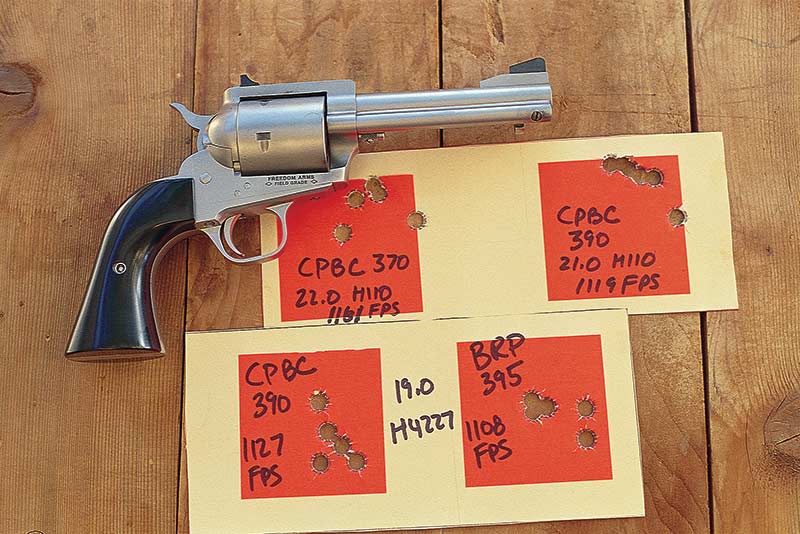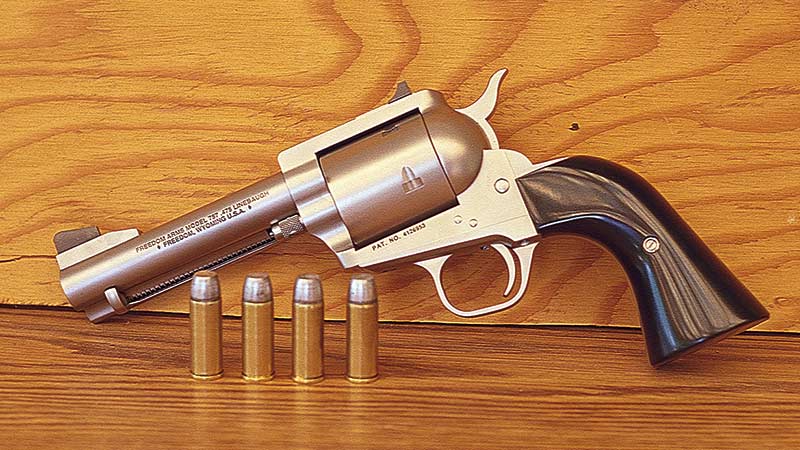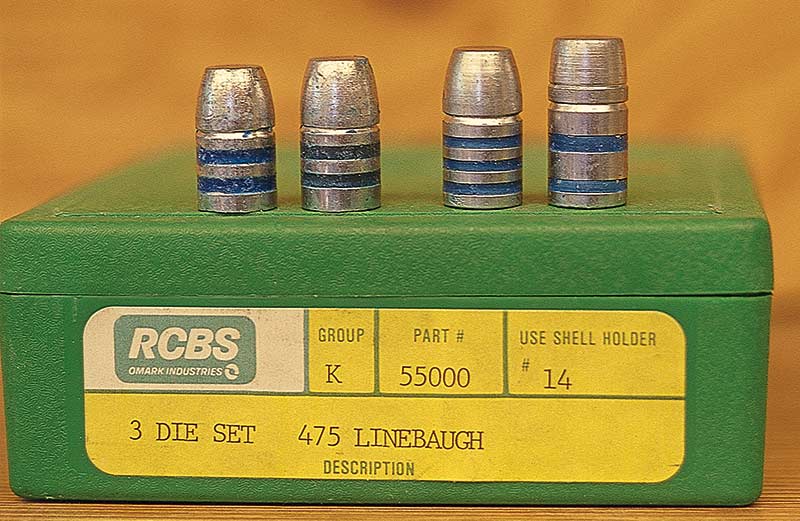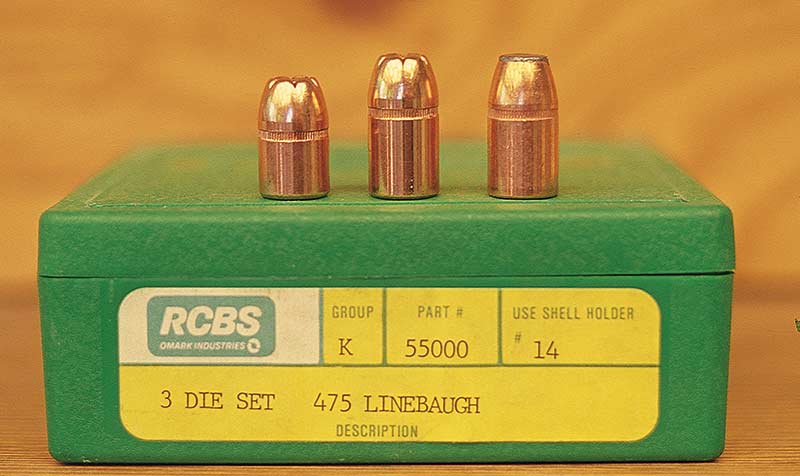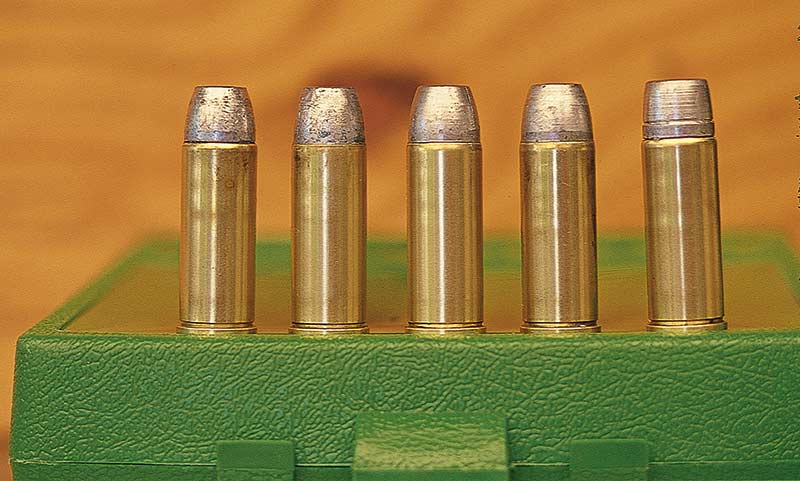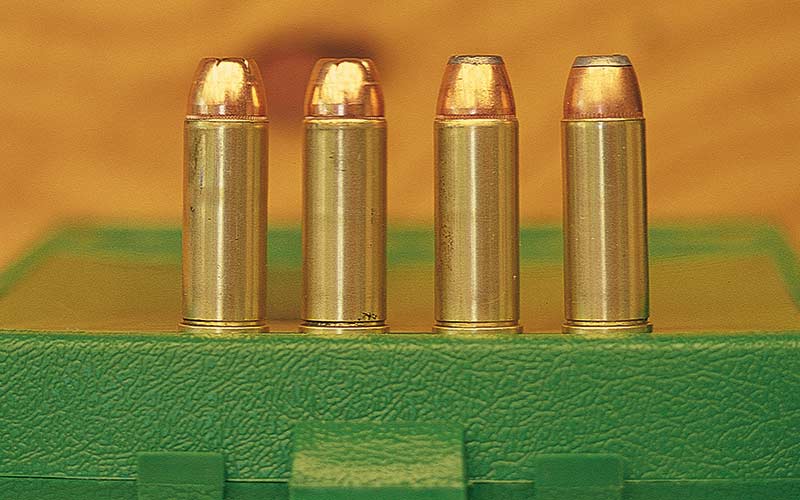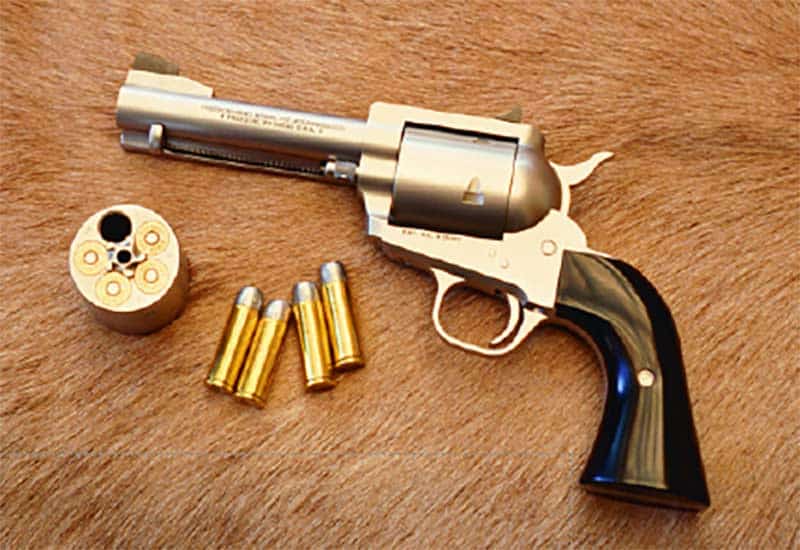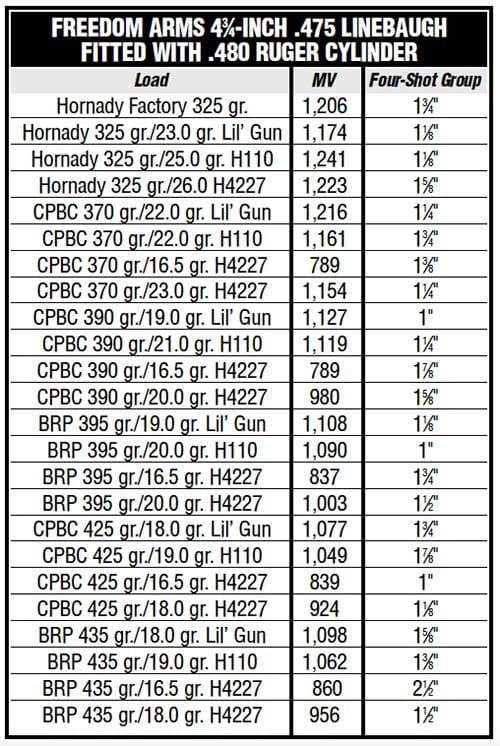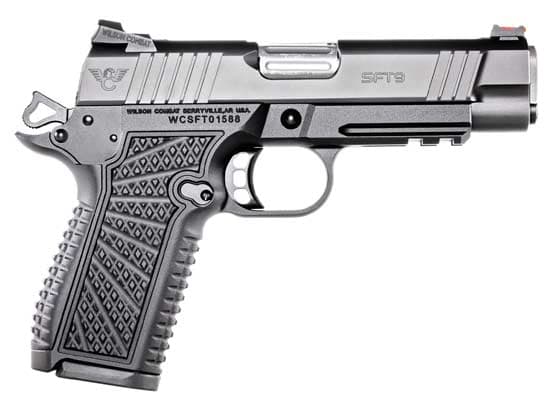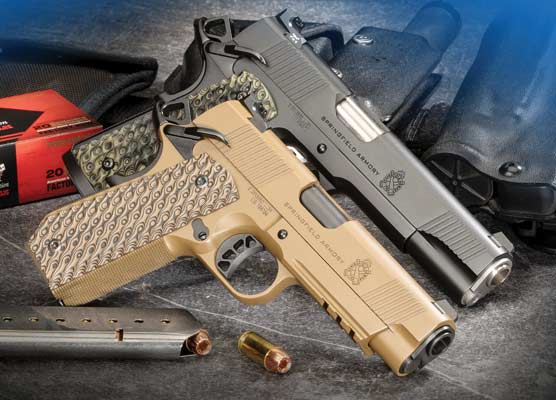Perfect Packin' .480
J.T. Investigates A Handy-Sized .480 Sixgun
Chambered in Ruger’s stainless steel Super Redhawk, which is available with either a 7 1⁄2- or 9 1⁄2-inch barrel, the factory loaded .480 is a relatively easy shooting cartridge when compared to other big-bore sixgun cartridges such as a .454 Casull, and the .475 and .500 Linebaughs.
If we cut through all the hype surrounding the .480 Ruger and look at it objectively, we conclude it’s a worth-while cartridge but certainly not one that stands head and shoulders above either a .45 Colt or .44 Magnum loaded with similar weight bullets. Using a 325-grain XTP JHP, the factory round clocks out at 1,350 fps from a 9 1⁄2-inch Ruger Super Redhawk. When fired into wet newsprint it expands beautifully and penetrates 17 inches. Which makes it, as currently loaded, a cartridge for those sixgunners after the deer-sized critters.
Does It Measure Up?
Is the .480 Ruger really on the same level as heavy loaded factory rounds for the .45 Colt and the .44 Magnum?Consider these statistics. Cor-Bon offers three loads for the .44 Magnum with heavy bullets: A 300-grain JSP at 1,300 fps, a 305-grain flat-point Penetrator, also at 1,300 fps and a 320-grain hard cast flat point rated at 1,270 fps.
From Buffalo Bore, we find a 305-grain LBT hard-cast LFN at 1,325 fps and a 300-grain Speer JFP at 1,300 fps. Switching to the .45 Colt shows a 325-grain LBT-LFN and a 300-grain Speer flat point rated at 1,325 fps from Buffalo Bore, while CorBon’s JSP is rated at 1,300 fps.
We have no intention of detracting from the .480 Ruger by quoting these velocities (which by the way check out as being accurately stated when fired in my sixguns), we are simply trying to put everything in its proper perspective. Also remember the .480 Ruger attains its factory velocity in a 9 1⁄2-inch barrel. When fired in an easier packin’ sixgun with a 4 3⁄4-inch barrel, the muzzle velocity is just slightly over 1,200 fps. This is still a powerful loading and more than sufficient for hunting deer and black bear.
Until now, the .480 Ruger has been avail-able only in Ruger’s Super Redhawk. This is a large, heavy, 58-ounce sixgun. I recommend it highly, especially for those who intend to hunt using a scope-sighted sixgun, as it does come truly scope-ready with Ruger rings at no additional cost. In addition to being chambered in the .480 Ruger, it is also available in both the .44 Magnum and the .454 Casull, allowing the shooter a choice of three cartridges that are excellent for hunting. The Super Redhawk is probably the strongest double action revolver ever offered to handgunners.
Sixguns Fit To Carry
But what about those sixgunners who want a more compact package? Their idea of a big-bore sixgun is more along the lines of my definition of the perfect packin’ pistol. That is, a big-bore sixgun with a barrel not less than 4 3⁄4 inches nor more than 5 1⁄2 inches when it comes single action style. This type of sixgun rides easily in a properly designed holster and would never be scoped. It is always readily available for close encounters and will be able to handle anything it is called upon to do.
Caliber is often dependent upon the area in which the sixgunner travels. For some, the .357 Magnum or the .41 Magnum are entirely adequate. For others the .44 Magnum or .45 Colt are better choices, and they may be better served by choosing the .454 Casull, and perhaps even the .475 or .500 Linebaugh. One of these cartridges, carefully chosen, will do any job that is needed from Africa to Alaska and anyplace in between.
Will the .480 be able to join this club? With this in mind, I called Bob Baker at Freedom Arms and we discussed the use of the .480 Ruger in a Freedom Arms Model 83. He agreed to provide a 4 3⁄4-inch barreled field grade Model 83 in .475 Linebaugh with an extra cylinder cham-bered in .480 Ruger.
One of my near-perfect packin’ pistols is another Freedom Arms Model 83, this one a 4 3⁄4-inch, premier grade .454 Casull with three extra cylinders in .45 Colt, .45 ACP and .45 WinMag. This has been one of my favorite do-it-all sixguns for well over 10 years now. The new .475/.480 would be in good company.
Ne Plus Ultra
For those who may not be acquainted with Freedom Arms’ sixguns, I will say without fear of contradiction these are simply the finest factory produced single actions ever! They are made of the finest and strongest steels available and the cylinders are line-bored. This means they are locked into one frame with one barrel and the pilot holes are drilled into the cylinder to perfectly align with that particular barrel and frame.
Every Freedom Arms revolver is made one at a time. They do not have a basket of frames, another basket of cylinders, and another basket of barrels that are picked at random and then put together. Rather each Freedom Arms sixgun begins with one frame, one barrel, and one cylinder, which are then assembled with as much care and precision as humanly possible. They are very expensive and well worth it!
As we mentioned, the factory loaded .480 Ruger from Hornady is a 325-grain JHP with a muzzle velocity of 1,206 fps from a 4 3⁄4-inch barreled sixgun, namely our Freedom Arms test gun with the .480 Ruger cylinder in place. It can be duplicated using Hornady’s 325-grain XTP JHP with 23.0 grains of Hodgdon’s Lil’ Gun, 25.0-grains of H110 or 26.0-grains of H4227. Both the H110 and Lil’ Gun loads are exceptionally good shooting loads.
Loading In A New Direction
In testing this .480 Ruger Model 83 I was more interested in heavy cast bullet loads, that is, bullets from 370- to 435-grains in weight. The Hornady 325-grain XTP-JHP is excellent when the main concern is expansion, especially in deer-sized animals. We already have this load and know we can duplicate it. I was more concerned about hard cast bullets that offer maximum penetration.
All loads were assembled using Hornady .480 brass and CCI No. 350 large pistol magnum primers. I have not seen any .480 Ruger reloading dies yet. However, RCBS .475 Linebaugh dies work fine once enough metal is removed from the bottom of the crimping die to allow it to crimp the shorter .480 Ruger round. In addition to the RCBS dies, I also used my old standby RCBS Rockchucker reloading press. I would hate to try to count the number of rounds that have been assembled with this single stage press.
I kept my powder selection simple by going with three Hodgdon powders that are favorites for assembling Magnum sixgun loads. These powders are H110, probably the best powder for full house loads in the .475 and .500 Linebaugh. The relatively new Lil’ Gun, which is fast becoming a favorite propellant among big-bore sixgunners as it seems to offer more velocity with less pressure and less powder used. And finally, the do-it-all powder for .45 Colt, .44 Special, and .44 Magnum for nearly 40 years now, H4227.
Good Commercial Casters
Bullets came from two sources, BRP and Cast Bullet Performance Company. Both of these companies offer a large selection of quality hard cast bullets for sixgunners. All of CBPC’s bullets are of the LBT (Lead Bullet Technology) design while BRP offers both LBT and Keith-style semi-wadcutters.
For these tests I went with CBPC’s 370-,390- and 425-grain LBT bullets, and from BRP, a 395-grain LBT and a 435-grain Keith. I wanted easy shooting loads for all bullets at around 800 fps, as well as top-end loads of 1,100 to 1,200 fps, depending upon bullet weight and several velocity choices in between. I found the .480 Ruger to be an exceptionally accurate cartridge with many loads, as you can see from the accompa-nying chart, usually delivering groups in the one-inch neighborhood.
Favorite loads include: The CPBC 370-grain LBT over 22.0-grains of Lil’ Gun for 1,216 fps and a 1 1⁄4-inch group. Either 19.0-grains of Lil’ Gun or 21.0-grains of H110 for right at 1,125 fps with CPBC’s 390-grain LBT and the same excellent accuracy. Also the CPBC 425-grain LBT for an easy shooting 925 fps with 18.0 grains of H4227, and once again superb accuracy.
Switching to BRP’s bullets, the 395-grain LBT over 19.0-grains of Lil’ Gun or 20.0-grains of H110 results in 1,100 fps and one inch groups. The 435-grain Keith bullet and 19.0-grains of a H110 runs slightly over 1,050 fps with excellent accuracy. This is more than enough for me with such a heavy bullet in the 46-ounce Freedom Arms Model 83.
Freedom Arms Model 83
Does the .480 Ruger fill a need? That is for each individual sixgunner to decide for themselves. I think it does. For me at least, it scratches an itch for one more good big bore sixgun cartridge. We now have two distinct classes of sixgun cartridges with the .44 Magnum, .45 Colt, and the .480 Ruger at one level. And the .454 Casull, and the .475 and .500 Linebaughs at the other. There is room in my sixgunnin’ for all of them.
During the time I was developing loads for the .480 Ruger in the Super Redhawk, I also fired the same loads in a Freedom Arms 7 1⁄2-inch Model 83 chambered for the .475 Linebaugh. For your reference I have fur-nished over 90 loads using six powders, five jacketed bullets, and five cast bullets. This is the most comprehensive data available for the .480 Ruger of which I am aware.

Get More Revolver Content Every Week!
Sign up for the Wheelgun Wednesday newsletter here:
